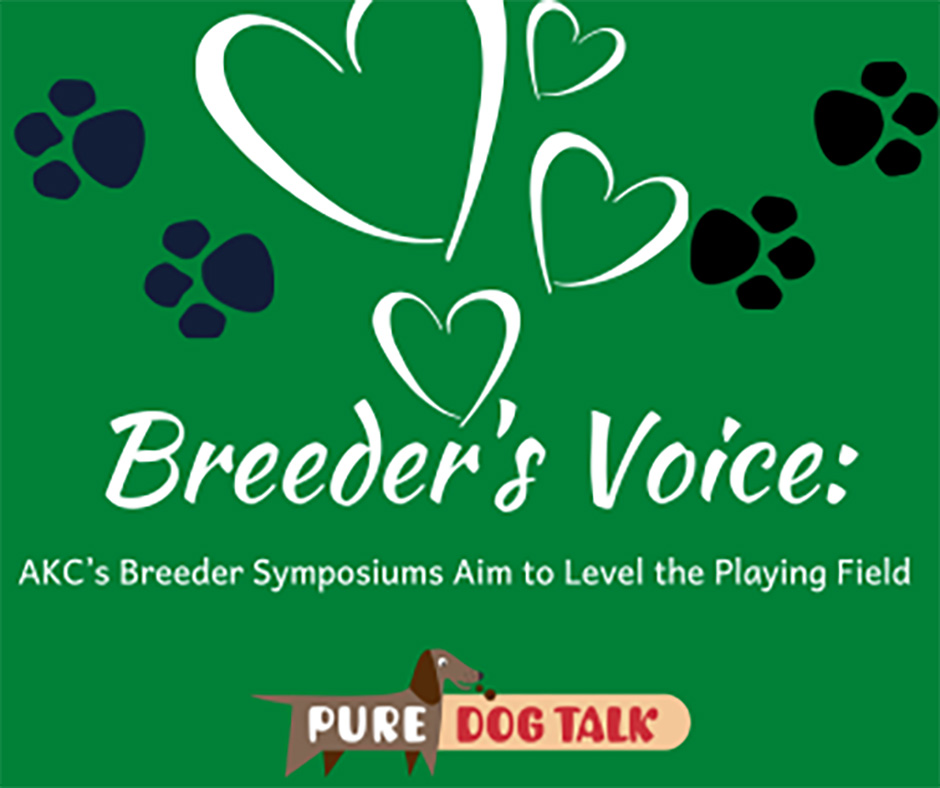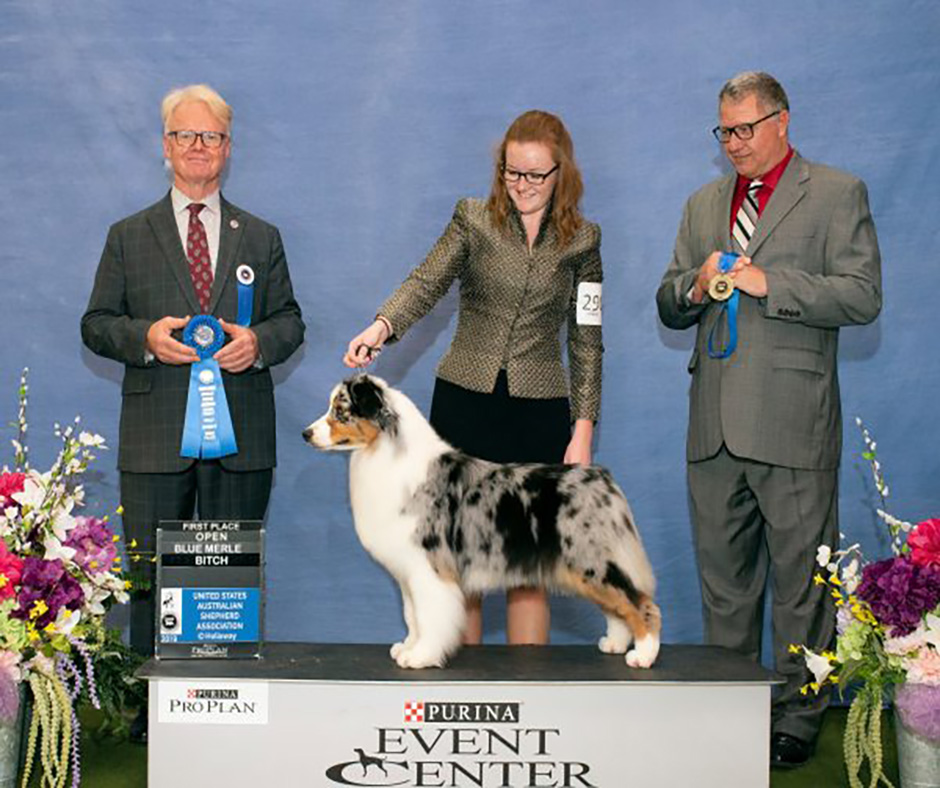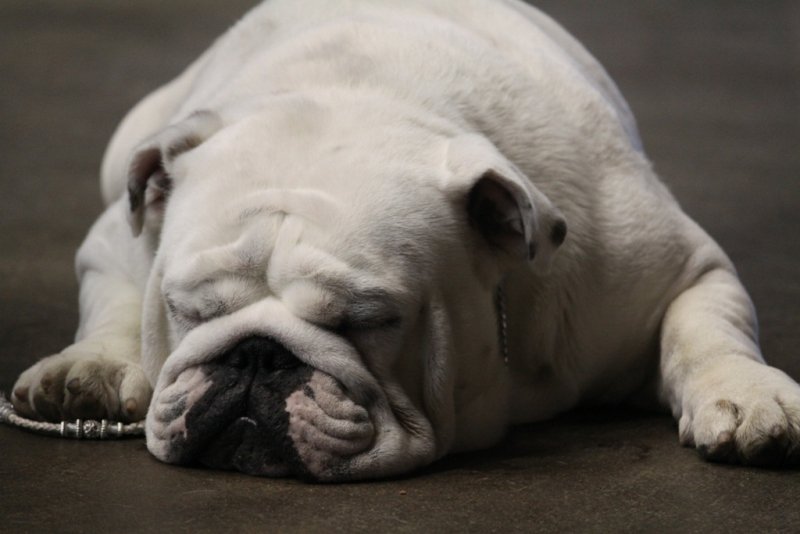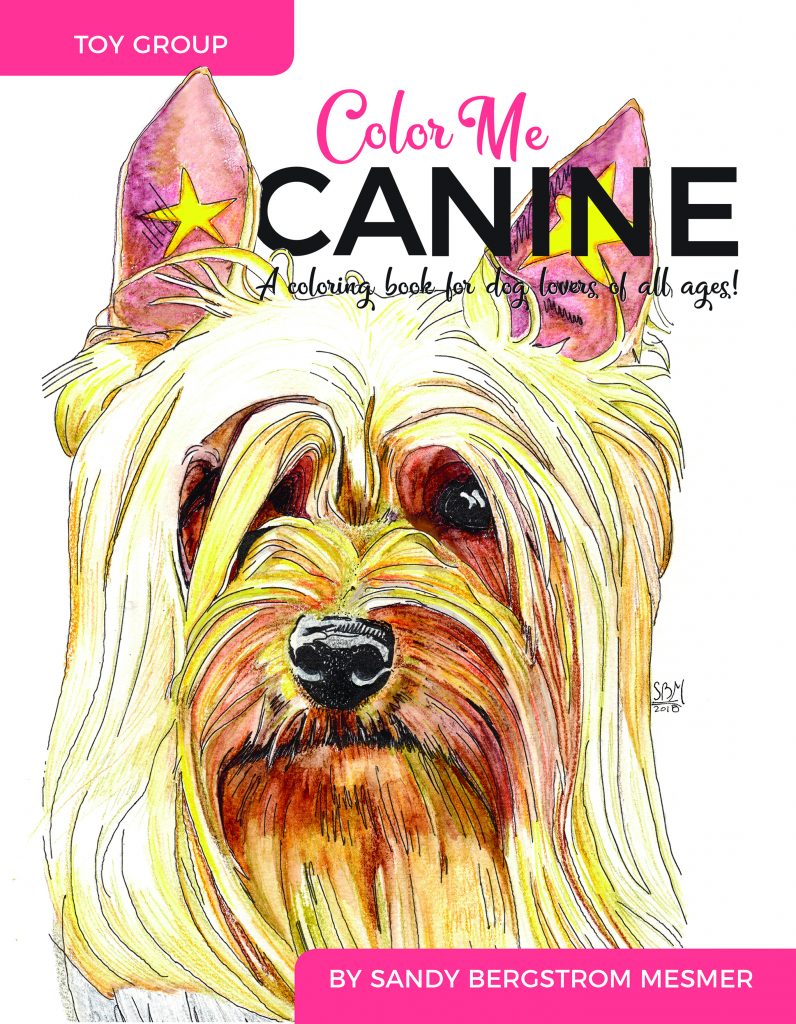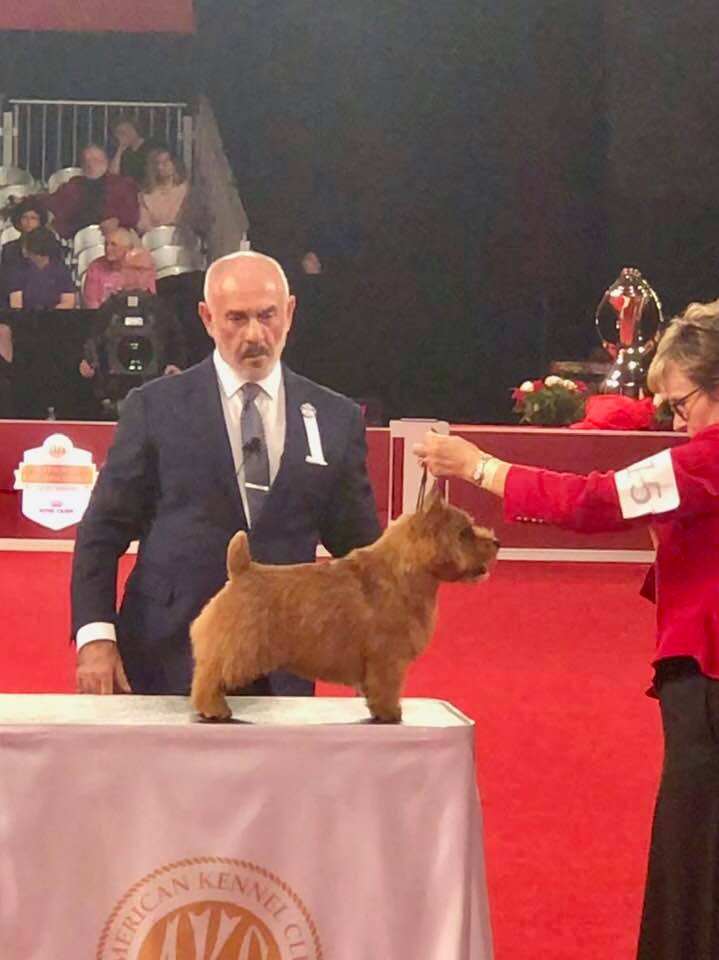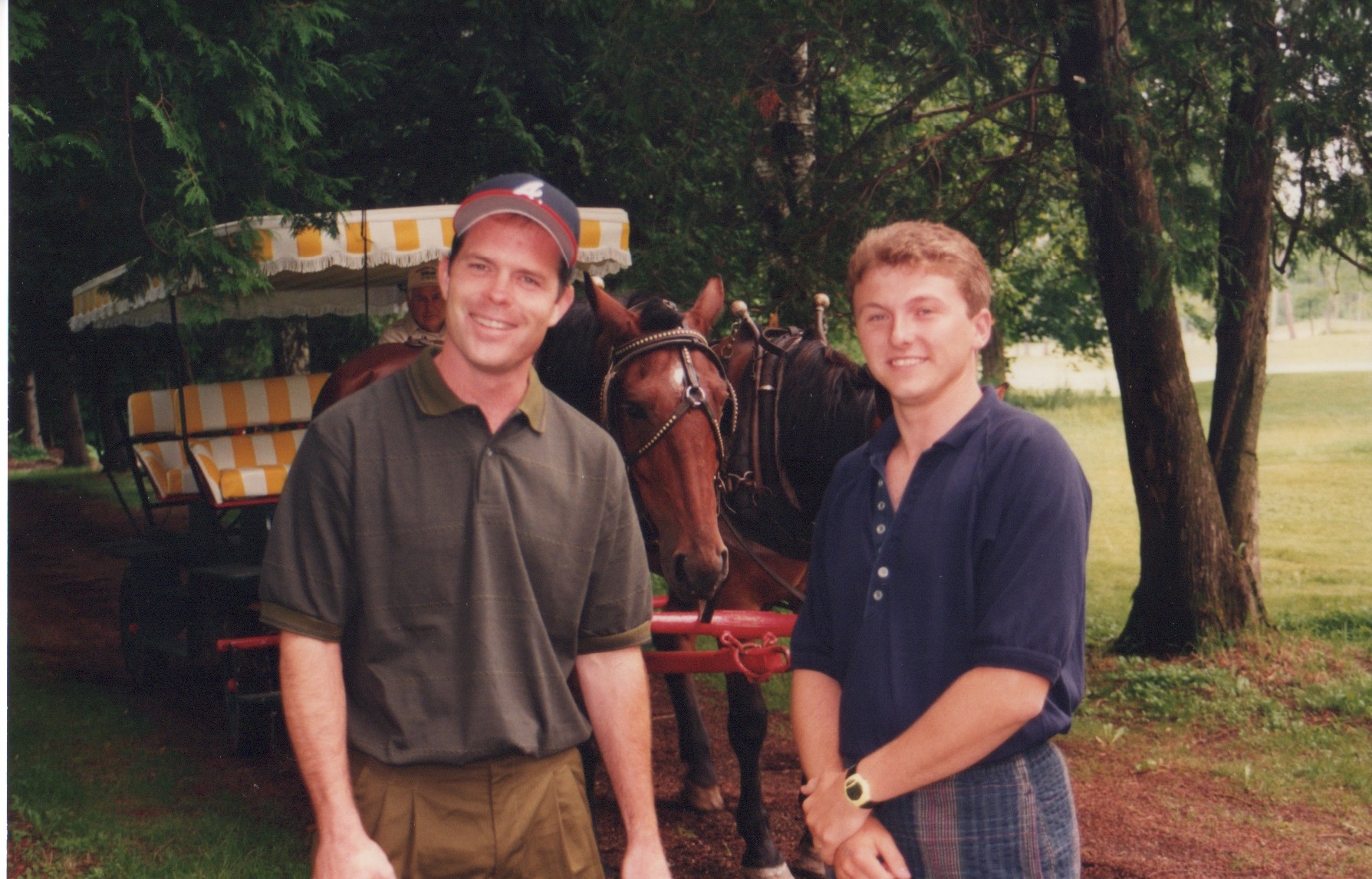606 – Protecting Breeds Into the Future
Protecting Breeds Into the Future
Dr. Marty Greer, DVM joins host Laura Reeves to discuss AKC’s newest service for preservation breeders. Greer was actively involved in AKC’s development of the Purebred Preservation Bank, taking the idea from the Otterhound Club of America. We had the conversation with Joellen Gregory early on about the Otterhound’s semen bank, and AKC has taken this and developed it into something that’s available for all parent clubs.
“(PPB will allow) AKC to fund the long -term storage of semen that no longer has an owner that wants to manage it,” Greer said. “So, you don’t necessarily have to have passed away for this to happen. If you’re at the end of your breeding program and you’re sitting there with six beautiful dogs that have semen frozen, and you’re like, ‘Well, I don’t have anybody I’ve really mentored and my kids don’t want it, so where do I go with this?’
“That’s when you go to the AKC website, you pull up the information on there, you sign the document that allows AKC to take ownership. And once you hand it off, you no longer are in control of that part of the semen. You may send all of your dog’s semen, you may send part of that dog’s semen, you may send all the semen that you have to the AKC, and AKC will then pay for the long -term storage.
“Every breed club makes their own rules. Your parent club can put together their health committee, their genetics committee, a special committee for this. Your breed club will sit down and with some ideas from what other breed clubs have done, be able to say, ‘This is how we want the semen disseminated. Does the bitch have to have a CHIC number? Does she have to have these certain criteria? When is it appropriate to use? Has she had a litter before?’ All those kinds of things, your breed club can decide.
“But as you release the semen, you can’t say, ‘Well, I don’t like Susie Smith.” Susie Smith is never going to get to touch my semen ever, ever, as long as I live, over my dead body. Maybe it will be over your dead body because now it’s no longer yours.
“Fifty years from now and 100 years from now, that’s what we’re looking at. We’re not looking at what happens next Tuesday when a bitch has to be bred. We’re looking at 100 years from now. Is your dog still of value? You might say things like, ‘Well, styles of dogs change,’ and indeed they do. But sometimes those foundational dogs are structurally what you need. Sometimes those foundation dogs predate certain genetic disorders that have really worked their way deeply into the gene pool and could be very hard to breed your way out of.
“AKC’s role in this is to pay for the semen storage and to register the puppies. That’s it. AKC is not there to start saying, ‘Well, we want you to do this with this and we want you to do that with that. And you have to have faith that 100 years from now, this mission, this vision is going to be held true. But it’s not about Susie Smith. It’s not about you. It’s not about (any individual dog). It’s about the overall health of the breed and where we can go with some of the genetics.”
581 – AKC’s Breeder Symposiums Aim to Level the Playing Field
AKC’s Breeder Symposiums Aim to Level the Playing Field
Host Laura Reeves is joined by Vanessa Skou, AKC’s Executive Director of Breeder Development and Erin Myers, project analyst for AKC’s Internal Consulting Group discussing the advent and development of the Breeder Symposium events.
Skou and Myers are both third generation dog breeders and former professional handlers. They describe themselves as still very much “in the trenches” of the fundamentals of breeding dogs.
“I know I have two litters on the ground,” Skou said. “And so we have personal experiences that we were like, ‘oh, wouldn’t it be great to have a class on this.’ Because those are the questions I have as well. So, if I’m having them, I’m sure somebody else is having them and that’s kind of where we bring our personal experiences into the play.”
“We want to be able to offer beginner and advanced tracks for people.” Myers said. “So if you’ve never bred a litter, you’re absolutely welcome to come. If you’ve bred 100 liters, we’re gonna have stuff for you.
“Education is that one thing, that kind of it puts us all on the same playing field,” Skou added. “We all can learn. Education is kind of that common denominator that we have. That we can all gain the insight from.”
“Without breeders, AKC doesn’t exist,” Skou observed. “AKC sports don’t exist and so encouragement of new breeders to even dip their toe in the water or those breeders that are having a hard time and getting downtrodden and feel like they’re fighting against the tide? Like anything we can do to encourage all of them.
“Because at the end of the day those puppy buyers are what really is what matters, right? They’re the ones that love that dog for its lifetime and make our hearts feel warm and fuzzy. We get to have our dogs to, you know, play with and show or performance, whatever it may be. But at the end of the day, we make so many people happy with that puppy. And so if we can do a such a good job to make everybody have a good experience to me, that’s that’s my job. And that’s why I take seriously.”
Sign up HERE for the Houston Breedeer Symposium in July!!
Visit YouTube for the video version of this interview HERE!
308 – Bill Shelton, chapter 3: bottlenecks, marketing, adaptability
Bill Shelton, chapter 3: Genetic bottlenecks, marketing, adaptability
Renowned breeder and judge Bill Shelton and host Laura Reeves finish up their wide-ranging conversation on dog breeding and marketing in the 21st century.
“How do we move the bar from healthier to typier to sounder? We have to breed,” Shelton said. “We have to be accountable for what we produce. But we have to breed. And we have to get the message out about how what we’re doing is producing healthier and happier dogs. How our ‘commodity’ is predictable.”
Bottlenecks are something we may all have to deal with at some point, Shelton noted. He references the Dalmation outcross project in which Pointers were incorporated to eliminate a deadly disease. He also talks about the Basenji project, in which native dogs from Africa are incorporated in the gene pool, again to eliminate a heritable disease. Listen to my interview with Damara Bolte on this topic here.
“It’s a heretic idea to many people, but it’s going to be something we all have to do at some point, because our dogs exist in closed gene pools,” Shelton said. “It goes back to the weaving of genes. You don’t eliminate bad genes, you introduce new good genes.”
Additional resources:
https://puredogtalk.com/busting-the-genetic-testing-myths-dr-jerold-bell/
https://puredogtalk.com/77-one-breed-one-world-think-and-breed-global-with-doug-johnson-2/
https://puredogtalk.com/german-pinscher-all-purpose-robust-dog-for-active-owners-pure-dog-talk/
Doodles offer a lesson
“How many people dislike labradoodles. Think back in the ‘70s when there were those dogs called Australian shepherds,” Shelton noted wryly. “People get upset because doodle breeders can sell their cross-bred dogs, when they (show breeders) can hardly sell dogs. Why? Because (show breeders) exist in a vacuum. They don’t advertise, they don’t promote their breeds, they don’t promote themselves, they don’t know how to do it. And then they say how bad AKC marketplace is. We want to show our dogs. But we don’t want to share them or market them.”
No dog left behind
Shelton espoused several outstanding marketing concepts, including making a dog’s microchip number its registration number. The public finds more value in the microchip than the registration number, he said. This plan would enable AKC to sell both more registrations and microchips and promote a campaign of “no dog left behind” because all purebred dogs would be registered and microchipped.
The entire series
If you missed the first two installments of this series, you can find them here and here.
304 – Bulldogs, professionals and imprinting type with Jay Serion
Bulldogs, professionals and imprinting type with Jay Serion

Jay Serion and Brix… Photo by Ryan Estrada Photography
Specialist Jay Serion talks about bulldogs, having pride as a handler, starting in the trenches and establishing a vision of type from understanding the standard.
“At my first dog show, my dog was third out of three,” Serion said. “I came out of the ring thinking, ‘we need to remedy this.’ Cuz I was competitive. I learned a lot.”
Serion’s recipe for success:
- Do the work outside the ring.
- Fix it in the whelping box not the tack box
- Start in the trenches. Success is not an overnight thing
“My mentors were honest,” Serion said. “They told me to read the standard. Learn the standard. Study pedigrees. Ask people. Ten people will give you 10 answers. There will be a common denominator, that’s your truth.”
Professional handlers all have a bar set of the quality they want to present, Serion noted.
“Especially if you are a specialist, it is part of your responsibility to campaign a good one,” he added. “I don’t want to waste money and time. And it takes a lot of both. I’d rather wait for a great one than push one that people that know *know* isn’t.”
A Bulldog Club of America approved mentor, Serion shares his knowledge about the breed’s outline and appearance.
“They’re supposed to be athletic. In my breed, the standard was written to save the breed from an influx of “Spanish dogs” that were huge,” Serion said. “The perfect bulldog must be of medium size. This was not arbitrary.”
Layback isn’t just for shoulders
The Bulldog standard is unique in that the term “layback” refers to the head structure. Serion describes this very specific construction as being from the tip of the lower jaw, tip of the nose, through the forehead to the occiput, should be a 45 degree angle in a straight line.
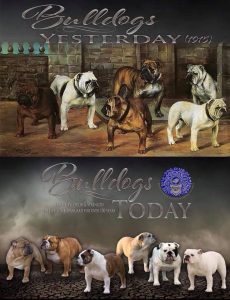
Illustration of the Bulldog then and now courtesy of the Bulldog Club of America.
“The dogs were used in bull baiting. The jaw needed to be strong enough to grab on to a bull and hang on, while the nose was pushed back so they could hold on and still breathe,” Serion siad.
Brachycephalic
“Our dogs are just as healthy as other breeds,” Serion said. “We’ve created an Ambassador of Health program in the national club encouraging health clearances.”
The program was created to provide proof of healthy dogs, testing everything from tracheas, to cardio, patella, spine, hips, elbows and more, Serion noted.
Temperament
Bulldogs originally were an aggressive animal to do the job, Serion observed. The original breeders wanted to keep the type features but eliminate aggression. “I’d never breed an aggressive animal no matter how pretty it is.”
For more on the genetics of temperament: https://puredogtalk.com/dr-karen-overall-temperament-vs-geneticspure-dog-talk/
293 – Coloring the Future: Artist Creates Purebred Dog Designs
Coloring the Future: Artist Creates Purebred Dog Designs
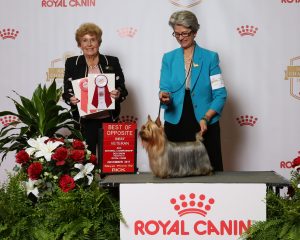
Sandy Mesmer and her Silky Terrier
Sandy Mesmer is an artist, Silky Terrier breeder and purebred dog enthusiast who has designed and published the first of a planned series of coloring books for each group.
“Color Me Canine: a Coloring Book for Dog Lovers of All Ages!” is Mesmer’s debut book in the series, this one covering the toy group.
Mesmer provides great insight about Silky Terriers in addition to her discussion of the coloring book, responsible breeders, taking back the conversation on purebred dogs and so much more.
“This book is a celebration of purebred dogs,” Mesmer said. “This is a viable alternative to the ‘adopt don’t shop’ message for children.”
“I am planning 7 more volumes of Color Me Canine, one for each AKC Group and Miscellaneous,” Mesmer added. “There are two areas that I could use help with:
- Part of the description I do for each breed is a crowd-sourced “In Three Words”. It can be helpful for someone to hear how the breed is very briefly described, it gives a snapshot of the breed’s temperament. You are very welcome to email me at sandy@smesmer.comwith your “In Three Words” for your breed. After all very breed is “great”. But is it independent? Sweet? Elegant? Feisty? All these adjectives can help a prospective buyer. As a matter of fact, as a thank you I’ll put you on our mailing list (if you’d like) so you can get the latest news about my coloring books.
- I have done over 160 headshots so far, these are the detailed drawings I use to model my coloring pages. They can be seen at the store (sandy-bergstrom-mesmer-designs.myshopify.com). I am working on the remaining 40+ as I work my way through each Group and am open to receiving photos of breeds I haven’t done yet. If I have done your breed, please feel free to check out your Headshot — I try hard to be an expert on each one but I know sometimes a detail slips through the cracks. As I can often easily correct such errors, I welcome experienced advice.”
Mesmer includes in the book, amongst a treasure trove of valuable information, this outstanding description.
What Makes a Responsible Pet Owner?
My friend and I got on the subject the other day. She volunteers at an animal shelter. We were having coffee. “I gotta tell you what happened.”
“Right before closing, I had this lady at my counter with a small black dog.
‘It’s not my fault,’ the lady told me. ‘This dog is obviously over-bred. I was promised that he wouldn’t shed, but he does – everywhere. And he pees everywhere too.
‘The kids begged and begged for a dog. I gave in but I told them, you’ll have to take care of him yourselves. And of course, they agreed. But did they? Of course not! It all got dumped on me. As usual. Never wanted the stupid thing in the first place.
‘Last night I got up to get a drink of water and stepped straight into a big pile of dog poop. That was the final straw.
‘I’m sure you understand I did all I could. The dog is obviously over-bred. It’s not my fault!”
My friend gave a deep sigh. “The woman so floored me, I couldn’t think of what to say. I came through the counter, took the dog’s leash and led him away. He’s a sweet little boy and no trouble at all. I took a long walk afterward.
“How can people get it so wrong?”
I shook my head. “No one ever tells people how to be a responsible pet owner. Instead they get their ears and eyeballs filled up with stories of Evil Breeders. Victimhood is so much simpler than to stand up and take responsibility.
“It’s way too easy to put a solitary bulls-eye on all breeders as the blanket cause of shelters full of abandoned animals. A good dog breeder is part of the solution, but so is a responsible pet owner.
“The popular press is curiously silent about this. It is loud about titillatingly horrific videos of stomach-turning breeding facilities, and we hear a lot these days about “over-bred” problem dogs.
“But what about the other side of the coin?”
I thought about our conversation over the next several days. What makes a responsible pet owner? I figured there were ten things to watch out for.
- A responsible pet owner is not in a rush to get a She knows that she is purchasing a companion who will be with her for the next 15 years. She does not try to get a dog for under the Christmas tree or for a birthday.
- A responsible pet owner never gets a dog just “for the kids”. She knows that at least one adult household member must be willing to be fully responsible for the
- Unless she is a responsible breeder, a responsible pet owner does not She never wants to “just have one litter” so the kids can see “the miracle of birth”.
- A responsible pet owner realizes that even with busy modern lifestyles, dogs need This is including regular walks. She knows that many canine behavior problems can be eliminated or at least mitigated with enough exercise.
- Whenever possible, she takes her dog with She knows that a happy dog is one with lots of stimulation and interaction.
- A responsible pet owner microchips her dog and has him registered with one of the lost and found She also has him licensed with her county.
- A responsible pet owner keeps up with her dog’s She checks him weekly for possible health issues and makes sure her dog gets regular wellness exams.
- A responsible pet owner trains her This can be in formal classes or from a book, but dogs love to learn; they become more sociable and excellent companions through training. If her dog has behavior problems, she is persistent in looking for help and answers and keeps going until she finds workable answers. She also realizes that if there is a persistent problem, most likely there is something that she is doing that is perpetuating the problem.
- A responsible pet owner continues to educate She keeps on learning about her breed, possible health issues and the latest in training protocols.
- A responsible pet owner knows that once she has made the original commitment, her dog is her responsibility for Like a child or a marriage, there are no give backs because the dog is no longer convenient or entertaining. It’s in sickness or in health, ’til death do us part.
I gave my friend the list. “What do you think?”
“I’m framing this and putting this on the wall behind the counter.”
“That would be great. If it helps just one dog have a better, more responsible owner, it’ll be worth it.”
I’ve heard about the excellent responsible pet ownership program they have in Calgary, Canada. Maybe that’s why that city has the lowest kill rate (how many pets are put to sleep) in North America.
Maybe this is the missing puzzle piece in the problem of pets in shelters. Just maybe.
291 – Shetland Sheepdog – Smart, Versatile, Adaptable
Shetland Sheepdog – Smart, Versatile, Adaptable
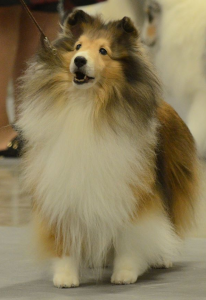
BISS Bronze GCh Solange Body Language, Flirt. Photo credit Cheryl Krajcar.
Host Laura Reeves visited the American Shetland Sheepdog Association National specialty for a multi-generational roundtable discussion of Shelties — what makes them good companions, fancy show dogs and fierce competitors in performance events.
The roundtable participants captured the breed beautifully. Shelties are “fancy for their size,” “athletic and eager to please,” “smart, versatile and adaptable.”
A long-lived, healthy breed, these experts said temperament and training impact how much vocalizing an individual dog will do.
While the experts agree that in years past, the quality of the sable color exceeded the others, today, they said, blue merle, tri and bi-black color dogs have improved in quality significantly.
Correct Sheltie expression, head planes and size are imperative to success in the show ring, our panel noted. They added that aspiring exhibitors need to be prepared for a “survival of the fittest” type commitment to the breed. A “young” breed, Shelties can be challenging to produce quality consistently, the panel noted, so new owners of show-potential pups are carefully screened.

ASSA Winners Bitch. Photo credit Cheryl Krajcar
According to “Shetland Sheepdog History” by Charlotte McGowan,
The history of the Sheltie is relatively recent and its earliest history is rather undistinguished. The Shetland Islands are remote and sparsely inhabited, although there is evidence of a long history as a stepping stone from Norway in ancient times. The general nature of the Shetland Islands, the windblown climate and somewhat sparse vegetation, have contributed to the miniaturization of livestock there in general. Because of the isolation of the Islands and the difficulty of making a living, animals there had to be very hardy.
The early native dogs were a very mixed lot but were generally very small, often 8-10 inches in height. It has been said that the ancestors of the dogs were Spitz type dogs brought from Scandinavia by early settlers, along with the large white Pomeranian, King Charles Spaniel, and smaller working sheepdogs from Scotland. The native dogs were rather inbred as no one kept more dogs than were needed for work.
The dogs were used to work Shetland Sheep, a small, extremely agile, almost goat-like breed. These original Island dogs were bred solely for utility. Because there are no fences on Shetland, the dogs did not do traditional sheep herding. They were used to drive sheep into rough stone enclosures so they could be dipped or “rooed,” as pulling the wool off them was called. They were also used to drive the rather wild sheep away from the crofter’s meager gardens. Another task was staying with the sheep on the more remote uninhabited islands in the summer. There they needed to be able to protect lambs from birds of prey like eagles, and traverse the seaweed covered rocks. The dog used its vocal abilities to bark at birds and scare them away. Barking was also a way to move sheep away from the croft and to locate the dog.
….
To continue reading this fascinating article, visit: https://www.americanshetlandsheepdogassociation.org/2016/07/08/shetland-sheepdog-history-mcgowen/
289 — Insurance Plans Go to the Dogs
Insurance Plans Go to the Dogs
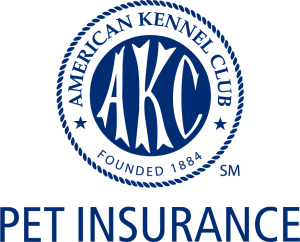 PetPartners President John Wycoff joins host Laura Reeves to talk about the how’s and why’s of insurance for our dogs.
PetPartners President John Wycoff joins host Laura Reeves to talk about the how’s and why’s of insurance for our dogs.
“Pets can get most of the same treatments people can get,” Wycoff said. “Costs of those treatments can be prohibitive.”
Cost Prohibitive Treatments
From foreign body ingestion surgery to chemotherapy for cancer treatment, these treatments for dogs can run in to the tens of thousands of dollars.
“Having pet insurance allows you to avoid a big financial burden when something happens later in your pet’s life,” Wycoff said.
Share the Risks
“Buying insurance allows you to share the risk of certain conditions that can happen with you, your pet, car, house,” Wycoff said. “You hope you never have these situations, but if they happen, you then have a plan to cover the catastrophic costs.”
Pet insurance is similar to human programs, but with no “networks.” Owners choose the level of coverage, deductibles, add-ons and can use their regular vet. There were 1,828,126 pets insured in the United States in 2017.
And, unlike car insurance, the number of claims submitted doesn’t affect the premium.
“Premiums are based on the coverage you choose, the age of your pet and the current market in your area at the time of policy enrollment/renewal,” Wycoff said.
The AKC Pet Insurance Blog offers the following tips for pet owners shopping for insurance:
Quick Tips
- Know What You Want – Determine the type of coverage you’re interested in purchasing for your pet before you start shopping.
- Do Your Research – Go online to review pet insurance providers and get a feel for how they conduct business. Read customer reviews and speak with anyone you know who has a pet enrolled with a company to get an opinion on ease of use, claim turnaround time, and customer service.
- Compare Providers – Ensure you’re getting the best policy for your pup by comparing the companies with the coverage options you desire.
- Customer Portals – A customer portal provides policyholders with the ability to log in to an account to access policy information, submit claims, and track a claim as it is processed. If you want to be being kept up-to-date on the status of your claims, you may want to choose a company that offers a customer portal.
- Pick Your Plan – Read through the terms and conditions of your potential policy to understand what is and isn’t covered. If you have any questions, give the pet insurance company’s customer service a call. When you’ve found the right plan, enroll your pet.
Wycoff noted that AKC Pet Insurance program provides 30 days of coverage with dog registration. For more information, visit https://www.akcpetinsurance.com/
286 – AKC Vet at the Junction of Tradition and the New Millennium
AKC Vet at the Junction of Tradition and the New Millennium

Dr. Jerry Klein at the AKC Museum of the Dog
Jerry Klein, AKC’s Chief Veterinary Officer, is at the junction of tradition and the new millennium. AKC created the position in 2015 to serve as a focal point for outreach to fanciers, veterinarians and the general public. Klein shares his history and journey in purebred dogs.
Klein started as a kid in the ‘50s with a “pet store” Wire Fox Terrier that he showed at his local show three years running in the Novice class. “I learned a lot,” Klein said. After observing poor sportsmanship at the show, he noted that “Learning how not to be was as important as learning how to show the dog.”
Exhibitor, owner, breeder, judge and veterinarian, Klein brings well-rounded experience to his role. He works with Diane Brown at the Canine Health Foundation and with Mari-Beth O’Neil in her veterinary outreach work, as well as recording “Ask the Expert” episodes for AKC TV.
AKC is an organization steeped in tradition, Klein said, that is working hard to bring its message into the new millennium.
“The best times are not behind us, but hopefully ahead of us,” Klein said. “We need to think of the future with a positive attitude.”
One area that Klein emphasizes is the inclusive nature of the purebred dog community.
“I always felt welcome in the dog world,” Klein said. “It’s so inclusive. I knew I was gay from a very early age. I saw dog shows as my way out. We are judged by what we bring to the table. If we breed quality dogs, we’ll be respected.”
Klein also noted that veterinary medicine has changed a lot in recent years.
“They can do more, but it is more expensive,” Klein said. This leads Klein to advocate strongly for pet insurance. As veterinary medicine parallels the quality of human medicine, we can’t “be stuck with our heads in the ’50s,” he noted.
274 — Pam Bruce: Crime Scene Investigator and Dog Show Judge
Pam Bruce: Crime Scene Investigator and Dog Show Judge

Pamela Bruce, Canadian and AKC judge.
Canadian and AKC judge Pam Bruce recounts her background working as a police investigator for the elite Special Victims Unit in Toronto in part two of her interview with host Laura Reeves. Bruce, a cancer survivor herself, (10 years ago in April she was given three weeks to live) reminds us that dog shows are not curing cancer or solving world peace.
Dog people are fascinating
Bruce was a real-life Mariska Hargitay in Toronto. Her professional life and dog life frequently intertwined in cases in which Dr. Richard Meen (CKC/AKC judge and long-time breeder) was called as an expert witness in cases dealing with young offenders in which she was the lead investigator.
“When I first came on (police work), there was a horse and a woman assigned to every platoon,” Bruce said. “Women were assigned to strip searches, sex assault and child abuse cases. They gave us the janitor’s closet to change in.”
Bruce spent only a year in uniform. Fascinated by sex offenders and dangerous offenders, she went back to school and specialized in DNA.
In another dog show and professional crossover, Bruce finds her “resting bitch face,” while useful in interviewing dangerous offenders, comes across as stern in the show ring.
“I learned it in interviews,” Bruce said “because you’re going in with dangerous offenders – all male – who know they can take you on physically, but are really interested in taking you on mentally.”
Do the research
“I am frequently shocked by the fact that exhibitors don’t know who they’re showing to. They don’t do their research to find out what the judge’s background in dogs is,” Bruce said.
“I have never once enabled anyone to speak badly to me about any dog,” Bruce noted. “And I’ve never denied a dog based on who’s on the leash – it doesn’t work that way.”
Listen to part one of the interview from last week.
171 – New AKC Department Supports Clubs
AKC Club Development Has Your Back
All breed and specialty clubs throughout the country are struggling. Members are aging, new members are few and far between. Some clubs are struggling financially, others burdened with a handful of active members. Some have even closed their doors.
AKC Club Development’s main focus is to help clubs grow. Whether that means providing ideas to recruit new members or offering guidance to organize events in a cost-effective and exhibitor-friendly manner. Success should be defined by the club, said Guy Fisher, Manager of Club Development. In a general sense, Fisher noted, success for a club is creating a fiscally strong organization with the means to support its members and community.
New AKC Department Created in 2017
Glenn Lycan, Director of Event Operations Support and Doug Ljungren, Executive Vice President of Sports and Events, looked around a couple years ago and noted that while the AKC had lots of resources for new clubs just getting started, they didn’t have a structured way to help existing clubs thrive.
“We had a goal to assist clubs to be more successful in every aspect of their development,” Lycan said. “… it’s funny you commented about how people think that the AKC is just businessmen in suits … that’s exactly how clubs looked at it, too. So, Guy’s first task, and what Guy has been excellent at, is letting clubs know that we are dog people, that we have a lot of dog experience, but we also have a lot of AKC experience and our phone is always available. We will help you. So, you hear about the glass ceiling. But AKC had a glass wall between clubs and us. And that was our whole goal for year one was to break that wall down so people felt comfortable coming to us.”
Dog people helping dog people
Fisher said he was literally born into the sport. His family raised Boxers and the Boxers raised him. An active member of all-breed and specialty clubs in Michigan, Fisher was a professional handler and his children remain active in the sport.
Lycan’s family bred Samoyeds and put him in charge of the kennel at 13 years old. He later went to work for Houston and Toddie Clark, then professional handlers and today well-respected all-breed judges. He apprenticed with them for three years, met his wife who also worked for them, and eventually began their own professional handling career in Georgia. There they were involved with their local all-breed club events and various national clubs as well.
Clubs Are the Backbone
“The clubs are our backbone of our sport,” Fisher said. “If we don’t have clubs we have nowhere to facilitate our sports and to participate. So, I always viewed it as a club needs to be a source of breeders owners owner handlers professional handlers to come together and educate their community within their territory.
“… And one of my main questions for clubs was what do you do for your membership. And a lot of clubs didn’t do anything … one of my suggestions was ‘how about trying to make it a little bit more of a fun, welcoming environment for these people’ so that they would want to … give off good positive vibes to the rest of the sport.”


